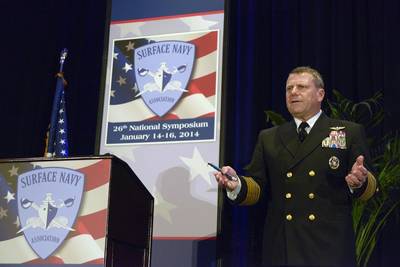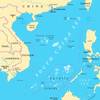New Navy O-FRP Emphasizes Training
The U.S. Navy's new Optimized Fleet Response Plan (O-FRP) was unveiled in a keynote address delivered at the 26th Annual Surface Navy Association National Symposium in Crystal City, Va., Jan. 15.
Commander, U.S. Fleet Forces Command Adm. Bill Gortney explained the changes to the new O-FRP, addressing Quality of Service and blending both Quality of Work and Quality of Life efforts by providing stability and predictability to deployment schedules over a 36 month O-FRP cycle. One of the highlights from his address was the Navy's efforts to lock in eight month deployment schedules for Sailors. These changes are intended to return a sense of normalcy to a Sailor's schedule by evening out the Sailor's family life and increasing retention rates and Quality of Work for their command.
"What's happened here is that over time ... we lost predictability in the way we generate readiness," said Gortney.
His address began by naming the problems with the current Fleet Response Plan, placing an emphasis on readiness through training.
"It doesn't matter how good the stuff is if people aren't there and they aren't properly trained," said Gortney. "Not only do they need to be on the ship ... they have to be there at the right time. If they show up after the training occurs just before deployment it's not going to work."
The plan aims to streamline pre-deployment inspection requirements and increase readiness by putting all the members of a strike group on the same maintenance and deployment schedule. Starting in fiscal year 15, all required maintenance, training, evaluations and single eight-month deployment will be efficiently scheduled throughout the cycle in such a manner to drive down costs and increase overall fleet readiness.
"The band is put together at the beginning of the maintenance period," said Gortney. "It's underneath a single chain of command for that entire three-year period. It's got a stable maintenance plan."
The plan puts a strong emphasis on training crews correctly.
"We're going to be training a lot of ships at the same time through that cycle," said Gortney. "A resource they need is trainers. We have to synchronize it so the trainers are there and everyone gets their reps and sets with the proper oversight that happens to be there and they're assessed at the right time."
The O-FRP is set to roll out implementation in 2014 with the Harry S. Truman Carrier Strike Group after its current deployment. It will initially be focused on Carrier Strike Groups and eventually will roll out to all U.S. Navy assets from the ARG/MEU to submarines and expeditionary forces.
The Surface Navy Association was incorporated in 1985 to promote greater coordination and communication among those in the military, business and academic communities who share a common interest in Naval Surface Warfare and to support the activities of Surface Naval Forces.
navysna.org















